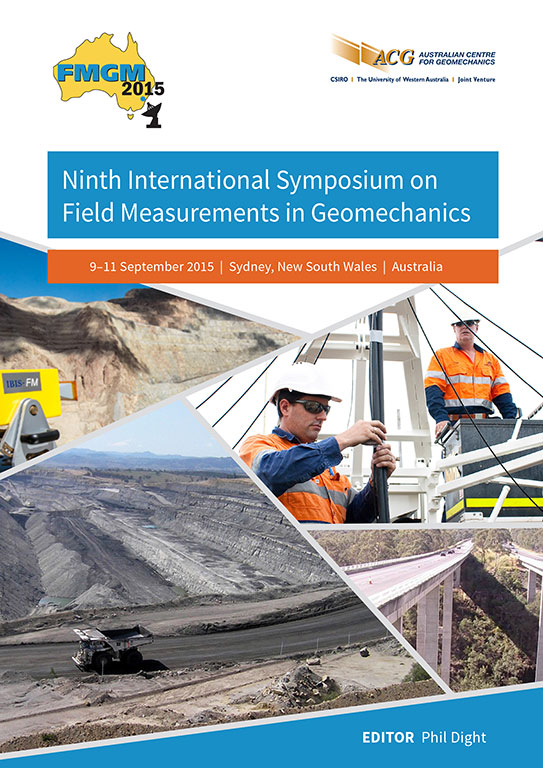Rock blasting — peak particle velocity against distance

|
Authors: Boon, CW; Ooi, LH |
DOI https://doi.org/10.36487/ACG_rep/1508_23_Boon
Cite As:
Boon, CW & Ooi, LH 2015, 'Rock blasting — peak particle velocity against distance', in PM Dight (ed.), FMGM 2015: Proceedings of the Ninth Symposium on Field Measurements in Geomechanics, Australian Centre for Geomechanics, Perth, pp. 365-371, https://doi.org/10.36487/ACG_rep/1508_23_Boon
Abstract:
The potential damage which could be induced by blasting in rock is normally evaluated with reference to the peak particle velocity (PPV). It is well-known that closer distances lead to higher PPV values. In some cases, due to muck handling logistics, the ramps forming the access result in different elevations across the different parts of a very deep excavation. Deep excavation access ramps and the completed base excavation ready to receive the concrete casting can be in close proximity to each other. In order to meet the construction schedule, the base slab has to be concreted while blasting works are still on-going at the access ramps. Hence, an optimised blasting programme is required to assure that construction progress is not unreasonably compromised, while vibration is kept under control. This paper first discusses the effectiveness of trenches to reduce vibration based on the findings reported in the literature, showing that this solution could be difficult to implement in practice because a very deep trench is required especially for hard rocks. Therefore, in most rock blasting programs, a more practical solution is to establish the distance beyond which PPV measurements are acceptable. This paper presents the data obtained from field measurements obtained from the excavation of an underground station in limestone rock. The vibrations were monitored from three permanent tunnel rings which are adjoining the boundaries of the underground station box, for which blasting was still on-going. An attempt is made to approximate the PPV with distance, and at the same time considering other factors such as the explosive charge weights in each delay, height of the free face, drill depth, drill spacing and number of holes.
References:
Alzawi, A & Hesham, El & Naggar, M 2011, ‘Full scale experimental study on vibration scattering using open and in-filled (GeoFoam) wave barriers, Soil Dynamics and Earthquake Engineering, vol. 31, no. 3, pp. 306-317.
Ambraseys, NR & Hendron, AJ 1968, ‘Dynamic behaviour of rock masses’, in KG Stagg & OC Zienkiewicz (eds), Rock Mechanics in Engineering Practice, John Wiley & Sons, Inc., London.
Ashref, A & Al-Hussaini, TM 1991, ‘Simplified design for vibration screening by open and in-filled trenches’, Journal of Geotechnical Engineering, vol. 117, no. 1, pp. 67-89.
Badal, R 2007, ‘Drilling and blasting for underground and open excavations’, in T Ramamurthy (ed.), Engineering in Rocks for Slopes and Foundations, Prentice Hall of India Pvt Ltd, New Delhi.
Beskos, DE, Dasgupta, B & Vardoulakis, IG 1986, ‘Vibration isolation using open or filled trenches – Part 1: 2-D homogeneous soil’, Computational Mechanics, vol. 1, pp. 43-63.
British Standard 2008, BS 6472-2:2008: Guide to Evaluation of Human Exposure to Vibration in Buildings – Part 2: blast-induced vibration, BSI Group, London.
Indian Standard 1973, IS-6922: Criteria for safety and design of structures subject to underground blasts, Bureau of Indian Standards, New Delhi.
Langefors, U & Kihlstrom, B 1978, The modern techniques of rock blasting, John Wiley and Sons, Inc. New York.
The Government of the Hong Kong Special Administrative Region 1998, Geoguide 4: Guide to Cavern Engineering, Geotechnical Engineering Office, The Government of the Hong Kong Special Administrative Region, Hong Kong.
United States Bureau of Mines 1959, Report of investigation 5483: spherical propagation of explosion of generated strain pulses in rocks, prepared by WI Duvall & B Petkof, Washington DC.
© Copyright 2025, Australian Centre for Geomechanics (ACG), The University of Western Australia. All rights reserved.
View copyright/legal information
Please direct any queries or error reports to repository-acg@uwa.edu.au
View copyright/legal information
Please direct any queries or error reports to repository-acg@uwa.edu.au